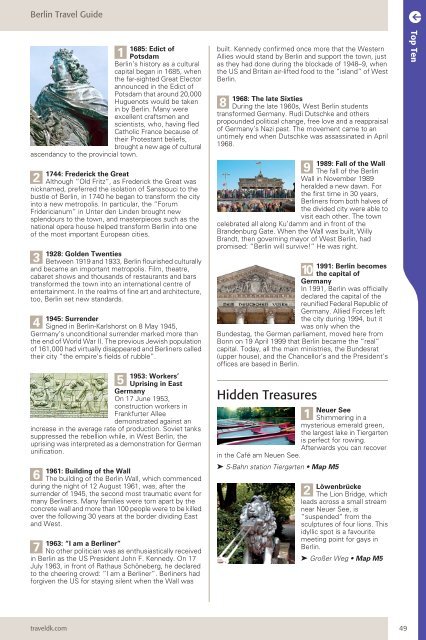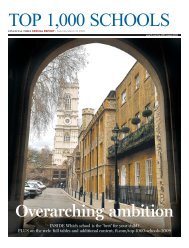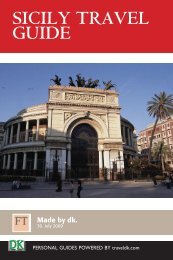Create successful ePaper yourself
Turn your PDF publications into a flip-book with our unique Google optimized e-Paper software.
Berlin Travel Guide<br />
1<br />
1685: Edict of<br />
Potsdam<br />
Berlin’s history as a cultural<br />
capital began in 1685, when<br />
the far-sighted Great Elector<br />
announced in the Edict of<br />
Potsdam that around 20,000<br />
Huguenots would be taken<br />
in by Berlin. Many were<br />
excellent craftsmen and<br />
scientists, who, having fled<br />
Catholic France because of<br />
their Protestant beliefs,<br />
brought a new age of cultural<br />
ascendancy to the provincial town.<br />
2<br />
1744: Frederick the Great<br />
Although “Old Fritz”, as Frederick the Great was<br />
nicknamed, preferred the isolation of Sanssouci to the<br />
bustle of Berlin, in 1740 he began to transform the city<br />
into a new metropolis. In particular, the “Forum<br />
Fridericianum” in Unter den Linden brought new<br />
splendours to the town, and masterpieces such as the<br />
national opera house helped transform Berlin into one<br />
of the most important European cities.<br />
3<br />
1928: Golden Twenties<br />
Between 1919 and 1933, Berlin flourished culturally<br />
and became an important metropolis. Film, theatre,<br />
cabaret shows and thousands of restaurants and bars<br />
transformed the town into an international centre of<br />
entertainment. In the realms of fine art and architecture,<br />
too, Berlin set new standards.<br />
4<br />
1945: Surrender<br />
Signed in Berlin-Karlshorst on 8 May 1945,<br />
Germany’s unconditional surrender marked more than<br />
the end of World War II. The previous Jewish population<br />
of 161,000 had virtually disappeared and Berliners called<br />
their city “the empire’s fields of rubble”.<br />
1953: Workers’<br />
Uprising in East<br />
Germany<br />
On 17 June 1953,<br />
construction workers in<br />
Frankfurter Allee<br />
demonstrated against an<br />
increase in the average rate of production. Soviet tanks<br />
suppressed the rebellion while, in West Berlin, the<br />
uprising was interpreted as a demonstration for German<br />
unification.<br />
6<br />
1961: Building of the Wall<br />
The building of the Berlin Wall, which commenced<br />
during the night of 12 August 1961, was, after the<br />
surrender of 1945, the second most traumatic event for<br />
many Berliners. Many families were torn apart by the<br />
concrete wall and more than 100 people were to be killed<br />
over the following 30 years at the border dividing East<br />
and West.<br />
7<br />
1963: “I am a Berliner”<br />
No other politician was as enthusiastically received<br />
in Berlin as the US President John F. Kennedy. On 17<br />
July 1963, in front of Rathaus Schöneberg, he declared<br />
to the cheering crowd: “I am a Berliner”. Berliners had<br />
forgiven the US for staying silent when the Wall was<br />
traveldk.com<br />
5<br />
built. Kennedy confirmed once more that the Western<br />
Allies would stand by Berlin and support the town, just<br />
as they had done during the blockade of 1948–9, when<br />
the US and Britain air-lifted food to the “island” of West<br />
Berlin.<br />
8<br />
1968: The late Sixties<br />
During the late 1960s, West Berlin students<br />
transformed Germany. Rudi Dutschke and others<br />
propounded political change, free love and a reappraisal<br />
of Germany’s Nazi past. The movement came to an<br />
untimely end when Dutschke was assassinated in April<br />
1968.<br />
1989: Fall of the Wall<br />
The fall of the Berlin<br />
Wall in November 1989<br />
heralded a new dawn. For<br />
the first time in 30 years,<br />
Berliners from both halves of<br />
the divided city were able to<br />
visit each other. The town<br />
celebrated all along Ku’damm and in front of the<br />
Brandenburg Gate. When the Wall was built, Willy<br />
Brandt, then governing mayor of West Berlin, had<br />
promised: “Berlin will survive!” He was right.<br />
9<br />
10<br />
1991: Berlin becomes<br />
the capital of<br />
Germany<br />
In 1991, Berlin was officially<br />
declared the capital of the<br />
reunified Federal Republic of<br />
Germany. Allied Forces left<br />
the city during 1994, but it<br />
was only when the<br />
Bundestag, the German parliament, moved here from<br />
Bonn on 19 April 1999 that Berlin became the “real”<br />
capital. Today, all the main ministries, the Bundesrat<br />
(upper house), and the Chancellor’s and the President’s<br />
offices are based in Berlin.<br />
Hidden Treasures<br />
Neuer See<br />
Shimmering in a<br />
mysterious emerald green,<br />
the largest lake in Tiergarten<br />
is perfect for rowing.<br />
Afterwards you can recover<br />
in the Café am Neuen See.<br />
1<br />
➤ S-Bahn station Tiergarten • Map M5<br />
2 Löwenbrücke<br />
The Lion Bridge, which<br />
leads across a small stream<br />
near Neuer See, is<br />
“suspended” from the<br />
sculptures of four lions. This<br />
idyllic spot is a favourite<br />
meeting point for gays in<br />
Berlin.<br />
➤ Großer Weg • Map M5<br />
49<br />
Top Ten





